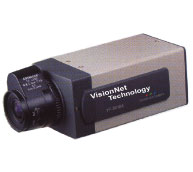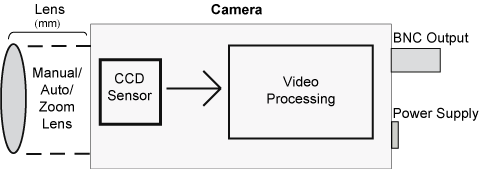|
Main
What is Video Camera
Overview
The starting point for any visual surveillance system
must be the camera. The camera creates the picture by capturing
image from real environment through its lens and image sensor,
of which will be transmitted to the control position, such as
control Center, Network DVR or CCTV system. Nowadays, there are
may different camera design to suit different complex
environment. For instance, Professional Video Camera for
mission-critical surveillance purposes, Doom Video Camera for
normal small-size retail stores, Convert Video Camera for
monitoring in concealment. |
 |

Details
Typical Video Camera composed by Lens, Image Sensor,
Processing Unit and Output Device.
| Lens: Just like photo camera,
Lens play important role in all image capturing units in the
world. It is used to gather the light from outside world,
focalize and transmit them to Image Sensor. Therefore, there are
many selection of Lens in the market, 2.8/4/6/8/12/16/25 mm
Lens, Fixed/Manual/Auto/Zoom type Lens. |
 |
| Image Sensor: After the
gathering of light by Lens, those light are needed to create
transmission signal to be any use. Image Sensor receive all the
light coming in, and product electrical charge for the creation
of a "Picture". The most commonly type of Image Sensor is CMOS.
They are low in cost, however, produce poor-quality of picture
especially dealing with our 3D complex real environment. CCD, is
an alternative, produces high-quality picture and clear color
distinctions. |
 |
| Processing Unit: It is the
main component of a typical Video Camera. It gathers all the
pictures generated from Image Sensor, and produce transmittable
signal to Output Device. Also, it controls the operation of
Electric Shutter, BLC and AGC. [See more at "Functionality"
part] |
 |
| Output Device: Simple, it
outputs all the signals to Center, Network DVR or CCTV System.
The commonly using interface is BNC. The 'BNC' plug is for
connecting the coaxial video cable. In practical use, Coaxial
Cable connects with BNC Output unit and take signals to
Recording Unit. |
|
Statistics
Statistics point to major reductions in the amount of crime
being committed where there are cameras installed. An article in
'New Scientist' magazine showed that simply installing a system can
reduce crime, in the areas covered, by over 95%. As our customers
inform us that they are having similar results in all types of
business, you will begin to appreciate why Visual Surveillance
System is seen by many as the best system for deterrent and
detection.
We are sure that you would wish to avoid having to catch those
who are perpetrating crime against your organization.
Generally, once a Camera system is
installed, it will only be fools who attempt to perpetrate offences
within its field of view. These are often caught but for
the majority it will provide a very high level of deterrence.
Typical Deployment
Traditional VCR
Method for recording video on tape with tape-recording equipment is
an analog type. Namely, each camera connect to one device
(Multiplexer) to split all the cameras’ image, and then output them
on a CRT monitor, and use VHS to record the image on video tape.
Operator then uses storage rack to protect tapes from humidity.

HIGH SETUP AND RUNNING COST
As the whole system involved many independent equipments,
Multiplexer, TV, several VCRs, immense amount of tapes and expensive
storage space that led to high running and operating costs.
LOW VIDEO QUALITY
Tapes would wear or tear over time, image would distort, video
integrity is hard to preserve over time due to changing climate and
humidity. This is an ever-present problem of analog tapes.
TAPE MANAGEMENT
User may have to review all the tape to find one specific image.
And large storage space is required for tapes. Spaces are noticeably
expensive in some cities such as Hong Kong. Keeping records for a
long period of time, such as one year, is impossible.
LABOR INTENSIVE
Systems need operator to change tape frequently and perform
system maintenance, and operator must be at the site to acknowledge
emergency.
LIMITATIONS
All the records stored on tapes. Viewer must go to the site and
take the tapes to see what was going on. When camera number has to
be increased, that also led to the problem of cabling, and
troublesome modification of the whole system.
Digitalization
All the
problems stated above found no solutions until the boom of digital
era. From cameras to digital cameras, from tapes to CD or Hard Disk,
from CRT to LCD, surveillance system also gets the same change -
VCRs to DVRs (Digital Video Recorder)
. From 2002 to 2003, DVRs constitutes up to 75% of new CCTV systems
in United States, especially after the terror attacks 9/11. With
continuous product improvement come better-functioning products,
lower costs, and a steadily growing customer base, products based on
digital technology begins to dominate the entire CCTV market.
We now use CD to replace
analog tapes, and all the captured images from cameras distribute
over the Internet, user can monitor from anywhere at any time.
Network
DVR
A Network DVR is a DVR linking CCTV
cameras together, and records all signal to Hard Disk, but at
the same time, provide remotely access from Internet or computer
network to download, replays record, being controlled by remote
user but without affecting normal daily operations.
Our DVR is TCP/IP based, that means:
Flexibility and Compatibility:
When every computer connects to the Internet, a unique IP
address is allocated to the computer, IP addresses are used to
locate computer locations in the world of Internet. When user's
computer and the DVR are IP-based, they can communicate with
each other and share information or resources.
Digitalization of Recording Technology
As the functionality, usage, quality and costs of VCR-based
surveillance system no longer satisfy present surveillance needs
and complex environment, that led to the development of DVR,
namely digitalized VCRs. Since the introduction, DVRs are
replacing traditional VCRs and sales are still increasing with
each passing year.
Digital video surveillance is the latest trend and development in the
security and surveillance industries. Customers are demanding more
advanced surveillance systems for more secured and effective security
monitoring. With advanced technologies and high speed data
transmission, DVR system makes traditional Video Tape-Based
monitoring and recording system obsolete.
Details
As all the
captured image is digitalized, the storage media were no longer
dependent on tapes. Images are stored as computer files on computer
Hard disk:
EFFICIENT STORAGE
DVR System uses computer hard disk for data
storage. Operator no longer change tapes frequently and hence save a
lot of spaces. And the storage time is also significantly longer.
LOW RUNNING AND OPERATING COST
DVR system do not need Multiplexer, separate recorder or large storage
space for tapes, this significantly reduce the operating costs.
EASY MANAGEMENT
DVR System uses computer hard disk for data
storage. Operator no longer change tapes frequently and hence save a
lot of spaces and labor. And the storage time is also significantly longer.
IMAGE PLAYBACK AND
DISTRIBUTION
As all records are in digital format, user
can easily back them up to CDRW, Floppy, or mobile rack. Also, user
can replay records fast or slow forward, backward, frame by frame,
zoom in or out, snapshot....etc
INTEGRATION
DVR is developed for replacing analog VCRs,
all the standard are almost identical to VCRs. User can easily renew
their system to DVR without technical works.
ENHANCED SYSTEM SECURITY
DVR provide multi-user login system, that enables system administrator
to control access of other DVR operator, that ensure internal settings
not being changed by third party.
Conclusions
However, a Digital
Video Recorder (DVR), digitally records the video image so it
provides clear image like a picture. It also has a function to
record continuously so you don’t have to worry about the frequent
change of tapes. With the easy distributed digital format, recorded
images, video and audio are easily distributed and viewed at home
desktops and notebook. DVR, therefore, is a video recording
surveillance system for the next generation and it is growing very
rapidly. By contrast, analog CCTV would be obsolete over time as digital technology takes over.
In dealing with small
business, especially retail shops, showroom, offices, franchises,
chain stores...etc Network DVR Technology is the excellent tool to satisfy their
needs, as DVR operator is not essential to smooth daily operation of
typical system.
For more
information:
Video Camera Selection Guide - White Paper |

